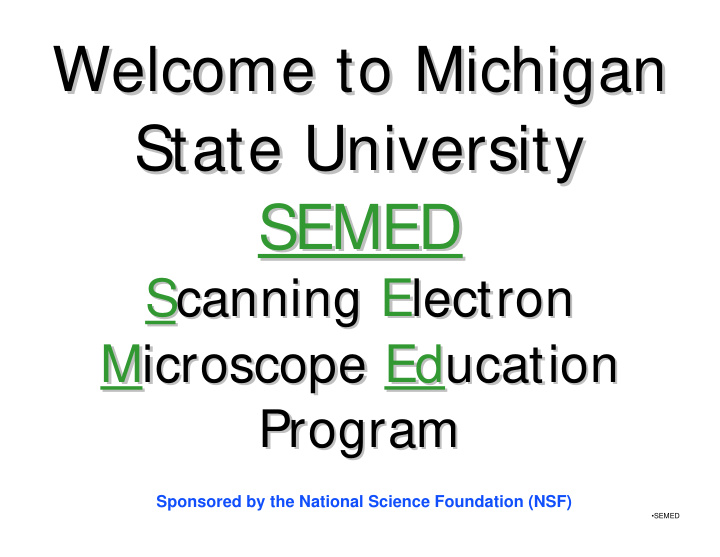



Welcome to Michigan Welcome to Michigan State University State University SEMED SEMED Scanning canning E Electron lectron S Microscope icroscope Ed Education ucation M Program Program Sponsored by the National Science Foundation (NSF) •SEMED
Definition Definition SEMED Session SEMED Session • Motivational science program • Established in 1991 by Air Force Research Laboratory (AFRL) SEM SEM Materials Directorate • Initiated at Alfred University in 2002 • Local junior and senior high school Bumble Bee Bumble Bee students and their teachers Tongue Tongue • Spend time learning about and using latest technology in scanning electron microscopes (SEMs) • Started at Michigan State Earwig Earwig University in 2002 •SEMED
Goals Goals • Demonstrate that science is fun • Show that scientists and engineers are real people • Identify career opportunities in science and engineering • Provide teachers with resources in electron microscopy • Demonstrate how science is used in a working environment • Establish a connection between the classroom and the real world •SEMED
Description Description • Rare opportunity for students and teachers • Hands-on experience with the latest high tech equipment • Fun and informative • Students meet and work with scientists and engineers • Run by MSU volunteers Mosquito • Conducted at the end of the work day •SEMED
Organization Organization • Informational meeting for teachers at start of school year • Teachers meet the volunteers • Program organization discussed • Teachers sign up for sessions • Teachers taken through a typical session • SEMED representative contacts teacher several weeks prior to scheduled session to confirm Ant Leg Ant Leg •SEMED
Program History Program History • A Challenger Center survey revealed teachers desired working with SEMs above any other scientific instrument • Challenger Center contacted the AFRL Materials Directorate • Meetings were conducted and a formal program was conceived and implemented • Students responded positively to hands- on work only • Program was quickly adapted to fill customer needs •SEMED
Current and Future Status at AFRL Current and Future Status at AFRL • Twenty-two sessions per year • Expand number of schools involved • Tech Trek - SEMED on wheels •SEMED
Session Description Session Description • Teachers arrive with students and are greeted by SEMED Volunteers • Volunteers introduce themselves and talk briefly about what they do • Group is given a 20 minute talk on what makes the microscopes work and what they are used for •SEMED
Session Description Session Description • Group goes to lab (4-6 students per SEM) • Volunteers explain how to operate the microscopes • Volunteers stand back and let the students drive • Typical session lasts about 1.5 hr • Students are encouraged to explore • Specimens are provided •SEMED
SEMED SEMED • Excites teachers, parents and STUDENTS • Motivates students to consider science as a career • Increases exposure of Michigan State University to local region • Increases volunteerism •SEMED
Light Microscope Light Microscope • 5-1000x • Two dimensional - limited depth of focus Mitochondria in Paramecium •SEMED
Scanning Electron Microscope (SEM) (SEM) Scanning Electron Microscope • 10-75,000x • Surface textures Mold spores on a leaf •SEMED
•SEMED Leica 360 SEM Leica 360 SEM
• Phillips 515 Phillips 515 •Phillips 515 • Scanning Electron Microscope (SEM) Scanning Electron Microscope (SEM) •SEMED
• Electron Backscatter Diffraction(EBSD) Electron Backscatter Diffraction(EBSD) • Samples Polished thru 0.06 µ m finish; 20 minutes w/colloidal silica. • • The 3 Sheet Orientations were investigated. Rolling Direction F – Rolling Face F CS – Cross Section L L - Longitudinal CS • EBSD performed on a Phillips 515 SEM with LaB 6 filament 0.5 µ m step size; typical area mapped: 400 µ mx300 µ m. • Digiview Camera SEM Chamber •SEMED
Bohr’s Atom Bohr’s Atom Electron Electron Orbit Orbit Electron Electron Nucleus Nucleus •SEMED
•SEMED Electron Gun Electron Gun
•SEMED Electron Gun or Filament Electron Gun or Filament Anode Filament Electron Stream Cup
•SEMED Electromagnetic Lenses Electromagnetic Lenses
Electromagnetic Lenses Electromagnetic Lenses Electromagnetic Electromagnetic ) Lenses Lenses “Focus the stream into a beam” •SEMED
SEM Construction SEM Construction Electron Filament Vacuum Chamber Anode Condenser Lens = Scan Coils Secondary Electron Scanning Detector Beam Specimen SEM SEM •SEMED
Television vs. SEM Television vs. SEM Electron Filament Vacuum Chamber Anode Condenser Lens Scan Coils Secondary Television Television Electron Scanning Detector Beam Electron Filament Specimen Vacuum Tube Anode SEM SEM Condenser Lens Scan Coils Scanning Phosphor Beam Screen •SEMED
Secondary Electrons Secondary Electrons Primary Electron Secondary Electron Primary Electron •SEMED
Secondary Electron Detection Secondary Electron Detection Secondary Primary Electrons Electron Detector Secondary Electron Escapes to Sample detector Surface Secondary Electron loses energy and is reabsorbed •SEMED
Secondary Electron Detector Image Secondary Electron Detector Image •SEMED
Backscattered Electron Detection Backscattered Electron Detection Backscattered Electrons, are Electrons from the incoming beam which have been Elastically Scattered back out of the sample. The number of backscattered Electrons generated increases with the Atomic Number of the specimen. •SEMED
Example of a Secondary Electron Image and a Backscattered Electron image. The image is from the glaze body interface of a coffee cup Notice that the glaze is much brighter in BSE and that there are crystals in the glaze which are seen in the BSE image and not in the SE image. Another thing to observe is the particle of dust ( very low atomic number ) seen in the SE image is not seen in the BSE image. Also, you can see bright rims around the pores in the SE image which are not present in the BSE image •SEMED
Characteristic X- -Ray Ray Characteristic X Characteristic X-Ray •SEMED
X- -ray Production Diagram ray Production Diagram X •SEMED
Top six pictures show earwig parasites Bottom two pictures are of a sand dollar •SEMED
•SEMED
•SEMED
•SEMED
•SEMED
•SEMED
•SEMED
Recommend
More recommend